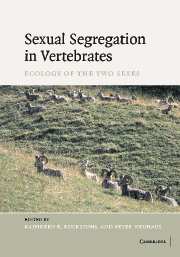Book contents
- Frontmatter
- Contents
- List of contributors
- Preface
- Part I Overview
- Part II Concepts and methodology
- Part III Foraging ecology
- 3 Sex differences in the foraging ecology of large mammalian herbivores
- 4 Sexual segregation in seals
- 5 Sexual differences in foraging behaviour and diets: a case study of wandering albatrosses
- 6 Differences in foraging behaviour and feeding ecology in giant petrels
- Part IV Predator avoidance and reproductive strategies
- Part V Sex-related activities and social factors
- Part VI Sexual differences in ecology: comparisons within different taxa
- Part VII Implications for conservation
- Part VIII Outlook
- References
- Index
4 - Sexual segregation in seals
Published online by Cambridge University Press: 04 September 2009
- Frontmatter
- Contents
- List of contributors
- Preface
- Part I Overview
- Part II Concepts and methodology
- Part III Foraging ecology
- 3 Sex differences in the foraging ecology of large mammalian herbivores
- 4 Sexual segregation in seals
- 5 Sexual differences in foraging behaviour and diets: a case study of wandering albatrosses
- 6 Differences in foraging behaviour and feeding ecology in giant petrels
- Part IV Predator avoidance and reproductive strategies
- Part V Sex-related activities and social factors
- Part VI Sexual differences in ecology: comparisons within different taxa
- Part VII Implications for conservation
- Part VIII Outlook
- References
- Index
Summary
INTRODUCTION
Seals have a worldwide distribution ranging from the high Arctic, through the tropics, to the coast of the Antarctic continent. They occupy the higher positions in many of the world's marine food webs and are increasingly being used as model species to monitor the health of oceans worldwide (Jouventin & Weimerskirch, 1990a). Historically, knowledge of their biology was restricted to periods when they could be observed on land or ice but even this was limited to the more accessible species. Advances in animal-borne recording devices, such as satellite transmitters and time–depth recorders, have lead to a rapid increase in the understanding of seal behaviour (Boyd, 1993b). A few decades ago, any attempt to investigate sexual segregation would have been extremely limited in its scope. Even today, knowledge is skewed towards the more heavily studied species and we can only consider segregation in terms of large spatial scales or distinct behaviours. Information that is often taken for granted for terrestrial organisms, such as foraging locations and basic diet, is simply not known for many species of seal.
The Pinnipedia is a diverse suborder, represented by some 33–37 extant species spanning three families (Berta, 2002). This diversity, coupled with their global distribution, is reflected in a large range of life history strategies. They show the greatest range of sexual size dimorphism of any higher vertebrate group (Ralls & Mesnick, 2002). In some species males can be ten times heavier than females (Fig. 4.1), whereas females are slightly heavier in others (Table 4.1).
- Type
- Chapter
- Information
- Sexual Segregation in Vertebrates , pp. 53 - 73Publisher: Cambridge University PressPrint publication year: 2006
- 2
- Cited by



